When you want to start a new hobby, there is a big fascination at the beginning. You want to understand how everything works and, at best, you already see yourself doing it! Often you are so hyped that you want to start right away. So you watch countless videos and slowly understand how the processes work. If you then want to start yourself, you are faced with the question: What do I buy now? I don’t want to throw money out the window – who knows if I’ll stick with the hobby? So you are often inclined to start with inexpensive products. Totally understandable! HOWEVER, I have to admit that some inexpensive supplies have the opposite effect. Namely, when frustration arises because it simply does not work. And as a beginner, you don’t know if it’s your own technique and lack of knowledge or if the product is unsuitable.
From my experience I can say: There are products where you can save money and don’t have to use high-priced products. And some professional products are much more beginner-friendly than their cheap alternatives.
Therefore, today I present you my top 5 frustration products and their recommended counterparts.
Ink rollers
Round steel frame with hard rubber rollers versus soft rubber roller. The former are probably the cheapest rollers you can find, while my favorites from Speedball Art are in the midfield price wise. Although this is relative, since there are rollers for 60 euros upwards, which are too expensive even for me!
The disadvantage of the round steel frame is that it does not tolerate much pressure. Unfortunately, however, the application of ink is so poor with these rollers that one is inclined to press on harder. Overall, applying ink with these inexpensive rollers is no joy … So the result remains rather uneven, which can have a negative impact on the print.
The soft rubber rollers, on the other hand, are a dream to work with. The ink can be easily and evenly distributed. In cleaning, hard rubber rollers are ahead, but for me the printing result has priority over cleaning a utensil.
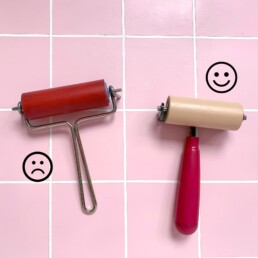
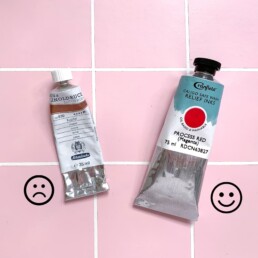
Ink - water or oil-based?
I started with large tubes of water-based ink and these Schmincke inks. A well-known company, should be working. Little did I know! While printing, the inks have partially dried, and to print in the summer was almost impossible. With a lot of pressure I tried to achieve an even result. In the end, I had to tear my paper off the linoleum block because it was sticking to it due to the dried ink. Pretty frustrating!
So my answer will always be: Ink for lino printing has to be oil-based AND washable. With oil-based inks, you automatically think of the tricky cleaning issues of having to handle smelly substances. I wouldn’t want that either 😀 Fortunately, there are the wonderful Caligo Safe Wash Relief Inks from Cranfield that combine the best of both worlds. Excellent printing qualities and very easy to clean with soap and water.
Carving tools
Here too, my credo is – please do not save money at the wrong end! With three different blade sizes you can already cover a lot of functions and are wonderful for a starter set. I used this interchangeable blade set during my time at university. A horror! Those in combination with a hard, old linoleum block spoil your fun right away. Because actually, carving can be meditative and relaxing.
Sure, carving is physically demanding – but the difference between a really sharp tool and a blade that gets dull after a short time – is huge! Sharp blades are also much safer for beginners, because you won’t slip as quickly as with dull blades! Mastering your tools and having a feel for them is also paramount for safe work – yet the “cheap carving tools” require much more control and experience than the high quality blades.
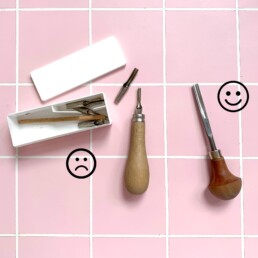
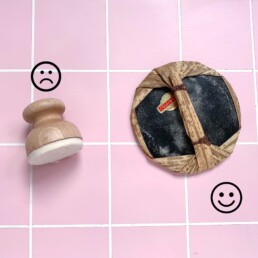
Apply pressure with the baren
My first baren was not really suitable for my project. You can use the felt baren for small stamp motifs for sure, but it’s nothing for lino printing. You can’t build up the pressure you need with it. Instead, the Japanese baren has been working wonderfully for almost 4 years now! You only make the first initial pressing with it and then switch to a wooden spoon, but it’s still part of the routine!
Paper - you can save here!
Fancy watercolor paper or heavy handmade paper with 300 gsm are eye-catchers! They feel luxurious and convey a certain value. However, these papers are not necessarily recommended for beginners and printing by hand. For a homogeneous print result, you need much more pressure and time. In contrast, papers in the 130-180 gsm range are much easier to print on, especially if it has little or no texture. My favorite paper comes from the print shop, 160 gsm, paper type “Design Offset White”. Similar papers can be found under the name “Cartridge”. Paper is certainly a matter of taste and also depends on your design. Monochrome floral designs can be perfected with a handmade paper. For beginners, I would advise choosing a paper that is easy to print on and then playing around as you gain experience.

Poor print results can be so frustrating. And even though trial and error is part of learning a hobby, we also need the “quick wins” to motivate us. The more often we do a thing, the better we get at it – but the “wrong products” can quickly take away our enjoyment.
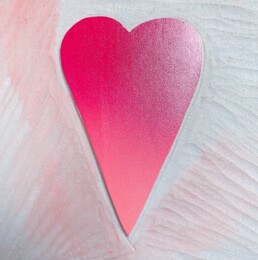
Conclusion
If you are not sure whether you want to stick with a hobby permanently, it is understandable that you want to save money. Good inks and tools can be resold.
If you already work with one of these products and get along with them well – all the better! I don’t want to say, that they don’t work at all! This might be personal experience and maybe I gave up on them too quickly. But all the products shown were game changers for me so I don’t want to withhold them from you. 😊
If you want to know which products can be useful for a lino printing beginner, download my PDF tool list! And if you want to get really serious about this hobby and make your first multicolor lino printing with the help of step by step instructions that are guaranteed to be frustration free, my online course is certainly interesting for you 🥳.
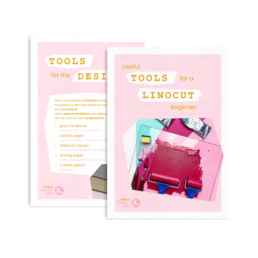
Linocut Tool Guide
Still unsure which tools and products you need for your lino printing starter kit? Just download my guide with product recommendations for linocut beginners – on 6 pages I list all the materials and tools I need to make my colorful prints – and you can do it too!
